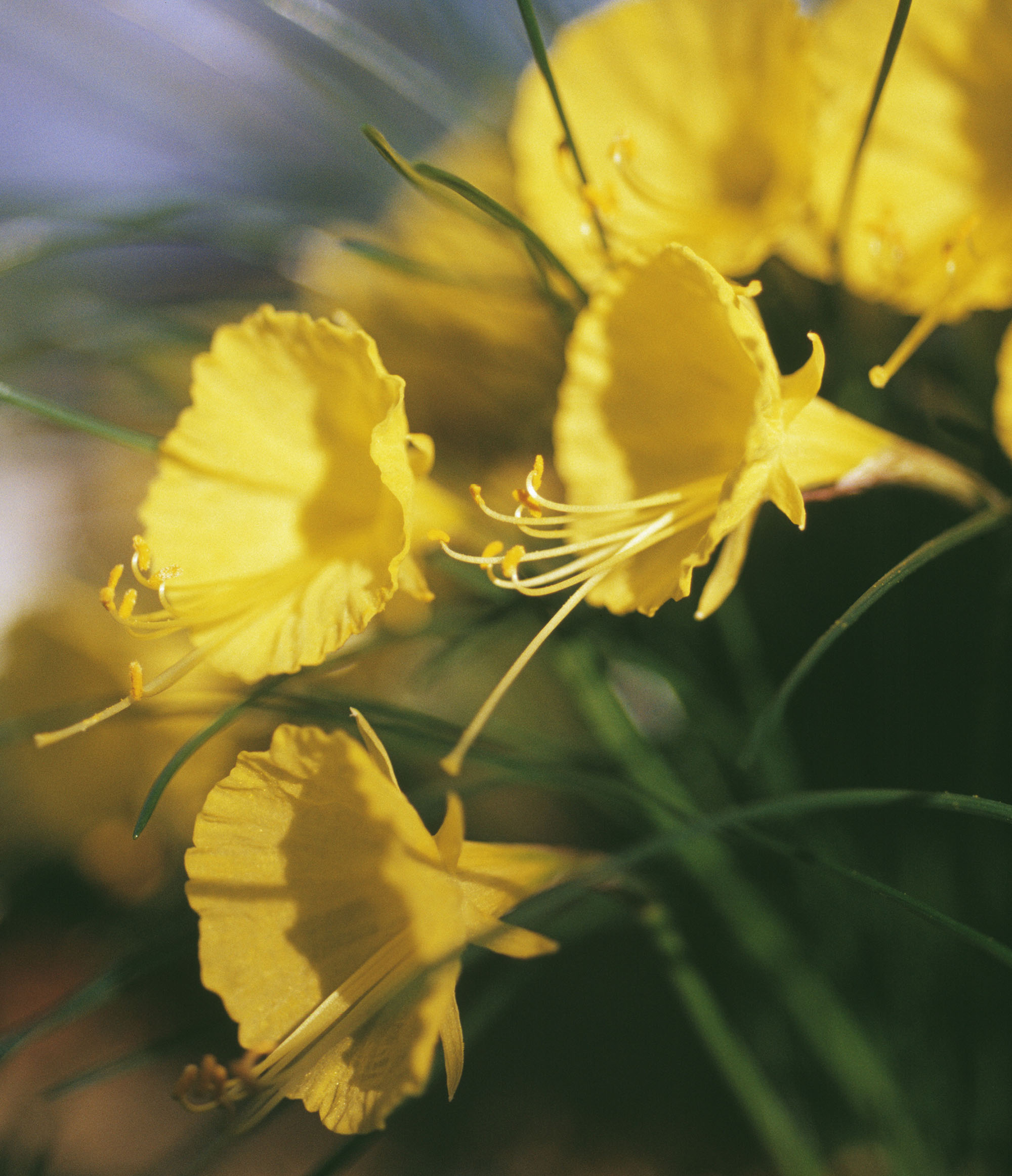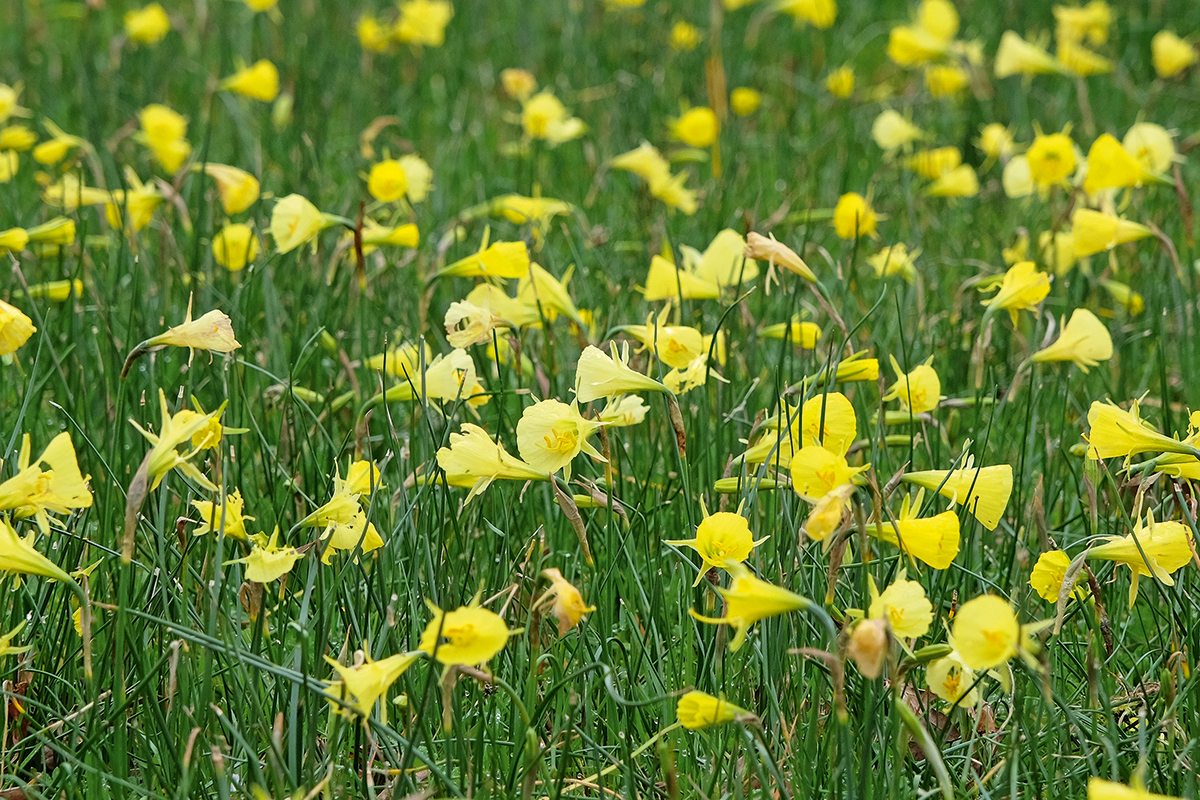The daffodil full of 'simple, dotty charm' that's the most generous of all Narcissus species
Charles Quest-Ritson looks at the endlessly cheerful hoop-petticoat daffodil, Narcissus bulbocodium.


Hoop-petticoatdaffodils is what the RHS calls them, but no one remembers the 1860s fashion for those uncomfortable waist-worn cages that concealed the ankles of Victorian ladies from upskirting gentlemen. Yet I am told such things may still form part of modern wedding dresses and are known by seamstresses as ‘bridal accessories’.
No other daffodil has the same shape. The trumpet part is an absurdly wide funnel, whereas the perianth segments (the five ‘petals’ behind) are very narrow — so narrow indeed that you may wonder what their function could be. The dark-green leaves are also so exiguous that you may not even notice them. The net result is that the cheerful, open flowers are what you see, usually bobbing in the breeze.
Narcissus bulbocodium is a popular garden plant. Every garden centre sells the bulbs and they are not expensive because they are easy to produce. They do not always establish themselves as you hope they will, but you can either move them to a better place in your garden or treat them as one-offs and plant some more bulbs next autumn. The wonderful thing about all bulbs is that you know they will produce flowers during the season after you bought them. Some, such as Spanish blue-bells, always clump up in subsequent years, whereas others — most tulips for example — dwindle away until nothing remains.
Narcissus bulbocodium come from the Spanish uplands, often in grassy pastures awash with snow melt. In a dry spring, you may need to water the bulbs exuberantly. They die back by May, when hot Hispanic summers mean that they cannot compete with the meadow grasses. If you can imitate that sort of lifestyle in the garden, they will thrive, seed themselves around and naturalise. It’s not difficult — you can see them in their millions at RHS Wisley in Surrey or the Savill Garden in Berkshire — and they are the most generous of all Narcissus species in the number of seeds every flower produces.

A carpet of Narcissus bulbocodium.
In parts of Spain, they are as common in spring as dandelions at home. Early one April, we drove some 40 miles along country roads from the town of Osorno to the outskirts of Burgos and found Narcissus bulbocodium was never out of sight. The colour was always the same — the merest shade less brilliant than dandelions — but in other regions there is considerable variety. In fact, there are innumerable subspecies, forms, shapes and colours throughout the Iberian peninsula — it is a species in an active state of evolution.
If you look carefully at the Wisley meadows, you will see how much their colour varies. Look more closely still and you’ll find the flowers have trumpets of different sizes, some with frills around the edges, others with lines in the trumpets that run out from the base. Sometimes, the leaves are long and straight, but on other occasions they are curved or curl along the ground. They are clearly a motley lot that have been added to from time to time — and they have had a very happy time miscegenating.
"It is hard to beat the simple, dotty charm of wild Narcissus bulbocodium and its many forms"
In the south of Spain and into Morocco, you find a pure-white form of Narcissus bulbocodium that some botanists (the ‘splitters’) call N. cantabricus, whereas others (the ‘lumpers’) consider it merely a regional variation. It is one of the earliest to flower — I have seen it near the coast of Granada province opening its buds in mid November, although it does not flower in the mountains of central Spain until May. This gives a clue as to how to grow all N. bulbocodium types — in a frost-free ‘cold’ greenhouse for flowers in good time for Christmas or somewhere in the garden for spring.
Exquisite houses, the beauty of Nature, and how to get the most from your life, straight to your inbox.
The natural habitat for Narcissus bulbocodium types varies enormously. It has for hundreds of years had a tendency to cross not only with its closest relations in the genus, but also with remoter cousins, producing new hybrids and, occasionally, new species. Genetic introgressions between populations occur regularly, which is why in central and southern Spain you often see a group of something different, probably of hybrid origin, within an apparently uniform colony. I love wandering around Spain in spring — I have found two hybrids of N. bulbocodium: the first was a cross with N. rupicola in the Sierra de Guadarrama and the other, in León, was a rather a pretty cross with N. triandrus, the white miniature daffodil sometimes known as ‘Angel’s tears’.
Narcissus remains a source of fascination for Spanish botanists, who churn out learned papers every year about what they have found in the wild. They are a companionable bunch, these botanists — all know each other and love their fieldwork because the plant is so beautiful and developing so fast. DNA testing has brought a reorganisation of the genus, but that does not stop hybridisation between species that are only distantly related. Although some charming hybrids are available from garden centres, it is hard to beat the simple, dotty charm of wild Narcissus bulbocodium and its many forms — which is more than can be said for hoop petticoats.
Charles Quest-Ritson’s book ‘The Olive Tree’ is out now (Ediciones El Viso, £50)
Charles Quest-Ritson is a historian and writer about plants and gardens. His books include The English Garden: A Social History; Gardens of Europe; and Ninfa: The Most Romantic Garden in the World. He is a great enthusiast for roses — he wrote the RHS Encyclopedia of Roses jointly with his wife Brigid and spent five years writing his definitive Climbing Roses of the World (descriptions of 1,6oo varieties!). Food is another passion: he was the first Englishman to qualify as an olive oil taster in accordance with EU norms. He has lectured in five languages and in all six continents except Antarctica, where he missed his chance when his son-in-law was Governor of the Falkland Islands.
